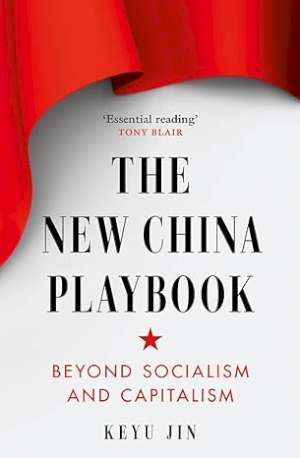24 November 2023
The New China Playbook
Beyond Capitalism and Socialism
Keyu Jin
2023, Swift Press, 368 pages,
ISBN 9781800753846
Reviewer: Kevin Gardiner, Rothschild & Co/Cardiff Capital Region

For the last two decades economists have been shifting their attention towards China, intrigued by its rapid growth. For those of us working in finance, much of this effort has been misdirected. China’s stunning growth seems if anything to have made the rest of the world a more attractive investment, and the most important driver of capital markets has remained the United States. Chinese assets themselves, where accessible, have disappointed.
This will surely change at some stage. Meanwhile, faced with many loudly-expressed opinions, how might we separate signal from noise? This book helps to do that.
It offers an objective and authoritative overview of China’s economy, its recent history, and the challenges and opportunities it faces. It is very readable: serious theory is diluted by colourful anecdotes. There are no equations.
The author is a well-connected associate Professor at the LSE with international NGO and private sector experience: she is Chinese, but also studied in the US. She does not assert that China must soon dominate the globe, but neither does she proclaim its imminent collapse in a dustcloud of debt default. She offers instead the rarest of things in this overhyped space – balance and nuance.
Jin’s subtitle tells us what to expect. She describes how China’s economic model is unique. It is no longer conventionally socialist, not yet conventionally capitalist, but nor is it simply somewhere in the middle. It has its own administrative characteristics – what she calls a “mayor economy” – and also its own distinct culture and values (including a widely-accepted paternalism).
She clarifies several misconceptions. Much of China’s growth has indeed been driven by productivity, not simply by capital and labour input. The impact of the one-child policy may have been economically more wide-ranging than we imagine. The “ghost towns” may not be as troubling as they look. China’s technological edge is best described as incremental, rather than ground-breaking.
She also describes how the government’s wariness of unpredictability has kept the financial system from maturing. This is where there is most work still to be done if China is to assume the global financial importance its GDP seems to warrant. I felt however that in talking about the potential wider adoption of its currency as a reserve asset she gives too much weight to trade invoicing, when the real reasons for its relatively low take-up to date are the logistical (and logical) obstacles of China’s structural current account surplus and capital controls.
In discussing recent trade tensions, I thought she was perhaps a little too generous to China: it’s hard to admit, but Trump had a point, and since China’s WTO accession the playing field has been tilted significantly in China’s favour. That said, she is right of course to note that the major drivers of trade imbalances are income, not substitution, effects. Finally, but perhaps understandably, Jin barely mentions the most likely source of future economic tension between China and the West – its non-negotiable claim on Taiwan.
Unusually for an academic economist, the author gives the stock market some considered attention, as an important component of China’s financial underdevelopment. China’s stellar GDP growth has not stopped China’s market indices from underperforming while also being more than usually volatile – not a happy mix. Recently, of course, many Western investors have decided that China is effectively “uninvestable” (not a view I share).
She suggests that much of the volatility can be explained by the lack of a more developed domestic institutional investor base, the resultant prominence of impatient retail investors, and a tendency to unfortunately-timed official intervention. I was less convinced by her suggestion that the poor performance is largely down to listing and sector mix considerations. The UK market’s experience tells us that such things do matter, but China’s tech sector is not that small.
Internationally-comparable measures show quoted-sector corporate earnings in China falling by almost a third in the last ten years, while those in the US, in common currency terms, have almost doubled. Meanwhile, China’s GDP has outpaced the US’s by roughly four percentage points per annum (these are my estimates). My guess is that other factors (price controls, government misdirection?) must have been at work too.
Overall, though, I enjoyed this book and learned a good deal from it. Tony Blair says it is “essential reading”. Don’t let that put you off.
